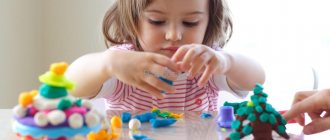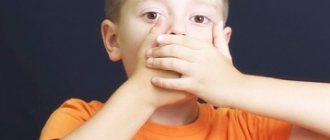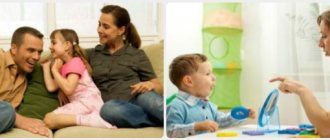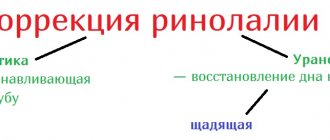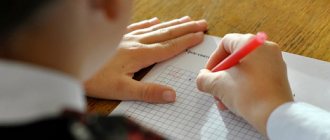Alalia is a systemic underdevelopment of speech function or its complete absence. The main causes of the disease are considered to be organic lesions of the speech areas of the brain that occurred in the first 2-3 years of life or in utero. The clinical diagnosis of alalia is made by a neurologist and a psychiatrist. In speech therapy, speech pathology caused by congenital or acquired brain defects is called general speech underdevelopment (GSD).
Alalia disease is characterized by:
- agrammatisms;
- distortion of sounds;
- late appearance of speech;
- violation of syllable structure;
- small vocabulary;
- violation of phonemic processes.
A patient with alalia needs to undergo a thorough neurological, psychological and speech therapy examination. The disease occurs in 1.5% of preschool children and 0.5% of schoolchildren.
Comprehensive treatment of underdevelopment of speech function includes:
- taking medications;
- physiotherapeutic procedures;
- working with a psychologist, neurologist and speech therapist.
Causes of alalia
Alalia disease is provoked by various anomalies of pre-speech ontogenesis.
In the antenatal (intrauterine) period, speech pathologies can be caused by:
- hypoxia;
- prematurity;
- torch syndrome;
- perinatal pathology;
- asphyxia of newborns;
- somatic disease of a pregnant woman.
Doctors note a genetic predisposition to the development of alalia. The history of patients with general speech underdevelopment reveals a chain of hereditary factors that provoke dysfunction of the speech areas of the brain.
Etiopathogenetic factors have a significant influence on the physiological development of the speech apparatus:
- rickets;
- meningitis;
- malnutrition;
- encephalitis;
- endocrinopathies;
- traumatic brain injuries;
- lack of competent child development.
In case of intrauterine, congenital or other organic damage to the brain in the first years of a child’s life, the development of nerve cells (neuroblasts) is inhibited. This pathology leads to neuronal inertia and functional depletion of brain cells. In case of alalia, multiple bilateral nature of deviations in the development of speech function, including compensatory capabilities of the brain, are diagnosed.
Alalia classification
Each area of clinical medicine has its own narrow classification of alalia, which is based on the causes of occurrence, existing pathologies of psychomotor development and the degree of speech underdevelopment.
Modern speech therapy suggests taking as a basis the classification of alalia by V.A. Kovshikov:
- Motor (expressive).
- Sensory (impressive).
- Mixed (sensorimotor).
Expressive alalia
In most cases, motor (experimental) alalia is caused by intrauterine organic damage to the cortical speech-motor analyzer. At the same time, the newborn does not have his own speech, but he perfectly perceives the speech of others. It is necessary to distinguish between efferent and afferent expressive alalia.
Efferent motor alalia is diagnosed with abnormalities of the premotor cortex (posterior part of the inferior frontal gyrus, Broca's area). The pathology manifests itself in kinesthetic articulatory apraxia (distortion of the sound of consonants and vowels). During physiological development, the premotor cortex in a child is responsible for the coordination and sequence of movements, which is very important for the formation of speech. Children with efferent alalia find it difficult to repeat a series of movements; they have difficulty reproducing correct articulation. It is with this problem that the phenomenon of persistence is associated: the inability to reproduce syllables in the required order.
Afferent motor alalia develops as a result of lesions in the postcentral zone (parietal parts of the left hemisphere). In healthy children, the postcentral zone is responsible for analyzing sensations at the time of conversation, and the synthesis of a motor program immediately occurs: open the mouth, lower the jaw, inhale air, raise the tongue. With afferent alalia, the child is not able to independently perform a chain of movements to pronounce sounds, so smearing, rearranging or swallowing of sounds occurs. Simply put, the baby has no idea about the sequence of actions of the articulatory apparatus when speaking, and it is difficult for him to reproduce movements even when repeating after his parents. In case of motor alalia with concomitant developmental pathologies, the child is assigned a disability.
Impressive alalia
The main cause of sensory alalia is damage to the auditory-speech analyzer in the cortical region (posterior third of the superior temporal gyrus, Wernicke's center). Patients with this disease have good hearing and developmental abilities. The main problem of correcting pathology is poor memory for pronunciation and a gap in understanding between the sound and meaning of words. The consequence of such dissonance is a lack of contact with others, a distortion of visual perception and a delay in the overall development of the child’s psyche.
Article:
Motor alalia is a disorder of the central nervous system of an organic nature, and therefore will require an integrated approach to treatment. An examination by a doctor with the prescription of medications, the work of a speech therapist using corrective techniques, and the active participation of parents are mandatory. The potential for self-development among motor alaliks is low, but it is there. Speech therapy work is focused on filling gaps in speech and non-speech development and preparing for school. Let's talk about some correctional techniques for children with varying degrees of motor alalia. Differential diagnosis of motor alalia Before starting correctional work, it is necessary to distinguish motor alalia from other disorders: sensory alalia, dysarthria, hearing loss, childhood motor aphasia, mental retardation (mental development delay) and speech development delay. The diagnosis of motor alalia is made by a neurologist no earlier than the age of four, since many mental functions in children, including speech, are in the process of formation. The speech therapist evaluates the sound pronunciation and prosodic side of speech in order to make a psychological and pedagogical conclusion: GRR, GSD (general speech underdevelopment) of level I, II or III. Before the age of 4 years, the diagnosis of RRD is usually made, but some signs of motor alalia can be seen from infancy. At the first stage, anamnestic data is collected to clarify the medical history. They find out whether the child previously had any speech or not. This makes it possible to distinguish motor alalia from childhood motor aphasia, since aphasia is the loss of existing speech, while alalia is the absence of speech from birth. A characteristic feature of motor alaliks is the absence of even babbling speech, which normally appears in a child from 5-6 months. They also find out the possible cause of the disease: asphyxia, birth trauma, infectious diseases of the mother or child, traumatic brain injuries of the child, etc. The purpose of clarification is to establish whether the disorder is organic or functional in nature and to distinguish it from ZRR. The second stage is an examination of speech understanding on the basis of differentiation from sensory alalia, in which the child’s perception and understanding of speech is grossly impaired. The motor alalik perceives and understands speech according to age. The child is shown pictures or toys and asked: show me where... The third stage is a hearing test to differentiate from hearing loss and deafness. In motor alaliks, the auditory function is preserved, while in those with hearing impairments it is impaired. The child is asked to guess with his eyes closed what sounds (non-speech sounds): rattle, tambourine, rustling paper, bell, etc. In addition, the prosodic components of speech are checked. Non-speaking alaliks, usually even without words, with the help of sounds, can convey intonation, melody, stress, rhythm of speech without gestures; children with hearing impairment are not able to reproduce the intonation pattern verbally; they use facial expressions and gestures. At the fourth stage, the child’s facial expressions are studied: mobile or static. In motor alaliks, in the absence of speech, facial expressions are very active, expressive; in dysarthric and sensory alaliks, sluggish facial expressions, amicity, spasticity of the articulation organs are observed; they cannot raise an eyebrow, puff out their cheeks, stretch their lips in a smile and stretch them out like a tube. The same test samples are used as for dysarthria. The fifth stage includes an examination of the articulatory organs in order to also differentiate motor alalia from dysarthria, in which the articulatory apparatus usually suffers. With motor alalia, the tongue, lips, teeth, and soft palate are usually normal. With dysarthria, there is an increased or decreased tone of the tongue, spasticity or pareticity of the lips, tongue, and soft palate. At the sixth stage, the sound pronunciation of existing phonemes is checked. Usually, with motor alalia, there can be both correct and distorted pronunciation of sounds; with dysarthria, all distorted sounds are constantly distorted. The seventh stage is an examination of mental functions. With motor alalia, a child develops negativism towards verbal communication, lacks motivation for activity, withdraws into himself, has difficulty making contact with strangers, which cannot be said about a child with mental retardation, who has developed motivation for action and the ability to master independent speech. Correction of motor alalia Since the leading defect of the disease is the absence of speech, the main task of speech therapy work is to form a psychological basis for activating attention, memory, thinking, developing positive motivation for communication and developing the need for this. Correction of speech activity depends on the level of speech underdevelopment. With motor alalia, the state of the language system is divided into three levels: OHP level I - speechless children, no vocabulary, by the age of 4 they communicate using gestures, onomatopoeia, babbling words: doo-doo, bi-bi, yum-yum, bye-bye . OHP level II is a gross distortion of the syllabic structure of a word; when the first slurred words appear, the grammatical structure of speech is disrupted, verbs are replaced by onomatopoeia, there are no prepositions, sentences are one or two syllables: bi-bi apapa - let's go to Anapa. OHP level III - phrasal speech appears, but the grammar and sound pronunciation are grossly violated: look, the dose is dripping, you need an umbrella datava - look, the rain is dripping, you need to get an umbrella. Work with level I OSD The primary task of developing the speech of children who completely lack it is to evoke a speech impulse, sound activity and help overcome negative speech motivation. You may need to consult a psychologist to help motivate your child. Why are we going to learn to talk? Here is a case from practice: a boy Kostya (4.5 years old) really wanted a Lego set, the set of which included cars from the cartoon Cars, but he did not know how to talk. Mom promised to buy a construction set, but on one condition: first, her son would learn to correctly name the names of all the cars. The child developed internal motivation and willingly visited a speech therapist. Parents at home can also help overcome verbal negativism by creating play situations, verbalizing objects, pictures, actions, and organizing various theaters. The speech therapist does the same thing in classes - he plays with the baby, using director’s games, theatrical shows, where he himself speaks for all the characters in different voices, gradually involving the child in the play action. It is impossible to force a speechless child to speak; negativism and complete refusal to speak are possible. The words of the speech therapist should be presented at a high emotional level. The child will begin to react with similar emotional exclamations of animals, facial expressions, and gestures. Any speech attempt should be rewarded with food or financial support. This is a kind of incentive. The goal of speech therapy work is to stir up and activate the child’s speech. Having evoked the slightest onomatopoeia, it is necessary to develop the active and passive vocabulary of alalik. Learn words on lexical topics in a playful way. For example, a game of “Cook”: let’s make vegetable soup, what should we put in the soup? And name the necessary vegetables: this is a carrot, this is an onion, this is a beet, etc. Or show pictures (POPPY, TANK, LAC), name the objects, then ask where is the poppy and where is the tank? What is this? A child can say to all the pictures: ak, ak, ak, but still encourage him and praise: yes, good, this is varnish. At the same time, the conceptual vocabulary is being developed: Tanya, Vanya, Manya. - And who is it? - ...anya - That's right, it's Tanya, - constantly praise the child, even if he called everyone by the same name. After the appearance of individual syllables, work is carried out to connect the syllables into words and phrases. Conjunctions and pronouns indicating place are used. This is Dad. This is a dog. The child can distort the words, but is already trying to construct a phrase, so he needs to be praised: you said a great thing! As the vocabulary accumulates, the formation of basic grammatical generalizations and contrasts begins. Children are taught using dolls to address each other: “Katya, stop!” Katya, go! - I am standing. “I’m coming,” the first child is responsible for the doll. - What is Katya doing? - teach you to ask a question. - Katya is standing. Katya goes, - the second child repeats, etc. At the same time, work is underway to develop fine motor skills of the hands, since the areas of the brain responsible for movement are very close to those areas responsible for speech production. With the child they make crafts from plasticine, finger paint, string beads, learn how to lace shoes, and fasten buttons. Completely imperceptibly, with well-developed, precise finger movements, new sounds and words can appear. Working with level II OHP Working with a motor speech disorder, who already has some distorted but separate words, will be much easier than with a speechless child. The most important task at this level is the formation of the grammatical structure of speech, developing the skill of independently changing words according to grammatical standards and models. You cannot use all grammatical structures at once; teaching should play a training and triggering role in mastering the mechanism of inflection. For example, several lessons are devoted to the use of constructions in speech with the control of the accusative case, using all the same lexical topics: “Vegetables”, “Fruits”, “Food”. What should we plant in the garden? – showing layouts and highlighting the endings with intonation: carrots, beets, cucumbers, potatoes, peas, melon, etc. Work is also underway on the syllabic structure of words by pronouncing and clapping, tapping, stamping words of varying complexity, and drawing up word diagrams divided into syllables. For better assimilation of the whole word and the development of phonemic perception, all pronunciations are accompanied by movements. First, two-syllable words with an open syllable are taken: ma-ma, di-nya (walking). Then three-syllables with an open syllable, etc., but until words with a combination of consonants are taken: che-bu-rash-ka (the word is longer, there are more steps). When mastering the syllable-by-syllable pronunciation of words, sound pronunciation is corrected according to the principle: production, automation and differentiation of sounds. Work continues on the development of fine finger motor skills. Work with level III OHP At this stage, the development of coherent, grammatically and phonetically correctly formed speech occurs. The work begins with the formation of a motive for activity and a program for a detailed statement. For motor alaliks, a detailed story plan is needed, which uses subject and plot pictures. Work also continues on the syllabic structure of the word, but with more complex words with a combination of consonants: bo-tin-ki, tul-pan, sve-to-for. Classes are conducted on the development of the grammatical side of speech, activation of the dictionary and correction of sound pronunciation (production, automation, differentiation of sounds). Next comes preparation for literacy training. Expected results Positive dynamics with motor alalia are possible if certain conditions are met: Early diagnosis of speech disorders. Timely prevention of secondary deviations. These may be non-speech deviations in fine and general motor skills. Accounting and comparison with the norm of speech development of a given age. Systematic speech therapy intervention with an emphasis on overcoming lexical and grammatical difficulties. Individual approach to each child, taking into account his personal and age characteristics. Simultaneous impact on mental processes of cognitive and speech activity. Working with motor alalik takes a lot of time; results cannot be expected quickly. On average, it can take from 3 months to six months to disinhibit and activate speech. Taking these aspects into account, parents will have to be patient and work very painstakingly and methodically with the child under the guidance of a speech therapist.
Alalia symptoms
Symptoms of motor alalia
With expressive alalia, the child is diagnosed with psychological and neurological abnormalities. Symptoms of nervous disorders can manifest themselves in a disorder of motor skills: poor motor skills, clumsiness, lack of coordination of movements. Such children find it difficult to cope with lacing shoes, fastening buttons, self-care, and putting together puzzles.
Characteristic features of the psychological development of patients with motor alalia:
- speech negativism;
- lack of attention;
- small vocabulary;
- low performance;
- poor assimilation of material;
- violation of sound pronunciation;
- deviations of the emotional-volitional sphere;
- hyperactivity or, conversely, inactivity.
It should be noted that there is a strong dissociation between expressive and impressive speech when diagnosed with “motor alalia”. The first speech skills (babbling, googling, sounds, phrases) appear with a delay and a characteristic reduction. The lack of dynamic development of a speech stereotype can be a consequence of stuttering.
Such children have a predominance of nouns in the nominative case in their vocabulary and difficulties in the formation of grammatical word forms. Speech in the motor form of the disease consists of simple short sentences, sometimes incoherent. The child is not able to consistently talk about things, convey events and explain the essence of phenomena. Intellectual development with motor alalia can be completely restored after correction of speech disorders.
Symptoms of sensory alalia
Characteristic symptoms of sensory alalia are:
- disturbances of perception;
- lack of ability to understand the meaning of someone else's speech.
Patients with sensory alalia experience hyperacusis: increased sensitivity to squeaks, rustles, the crunch of snow, the sound of rain, and the rustling of paper. Children are acutely aware of such side sounds and may experience discomfort in their ears and head.
Impaired phonemic hearing in the sensory form of the disease prevents patients from correlating heard words with objects or phenomena. During speech therapy sessions, children with sensory alalia develop logorrhea - incoherent reproduction of all familiar phrases and sounds, while speech is accompanied by gestures and lively facial expressions.
In the severe form of sensory alalia, the patient is diagnosed with a complete lack of speech and understanding of others. Experts practice teaching “lip reading,” which makes it much easier for a child to comprehend speech. Children with sensory alalia are often misdiagnosed as autism, hearing loss, mental retardation, dysarthria.
Separately, sensory underdevelopment of speech function is quite rare. In most cases, sensorimotor alalia is diagnosed. This double pathology indicates the inseparability of the speech-motor and speech-auditory analyzers.
If you experience similar symptoms, consult your doctor
. It is easier to prevent a disease than to deal with the consequences.
Clinical picture and behavioral characteristics of children
Children with motor alalia are distinguished by the following characteristics:
- Preserved intelligence. The child learns normally, understands gestures, recognizes pictures, and recognizes familiar people.
- Incorrect use of voice. Your baby may speak too loudly or too softly.
- Incorrect pronunciation of words and sentences (the child does not speak, but rather babbles), while voiced and soft consonants sound correctly.
- The baby does not respond to questions and finds it difficult to answer.
There is also a more severe form of alalia: with it, the child understands the address, but does not speak at all.
In addition to speech problems, a child may exhibit other typical symptoms, for example, children often experience fatigue, especially during learning. Excessive activity, interspersed with periods of fatigue, is common. Many children experience either severe inhibition or severe disinhibition, depending on the characteristics of the injury.
Important! Alalia does not occur due to stress or difficult life events. Its cause is brain damage, not fear or psychological trauma.
Diagnosis of alalia
Patients diagnosed with alalia need to be examined by the following specialists:
- Speech therapist - for perinatal history, identifying features of speech and psychomotor underdevelopment, as well as drawing up a model of lexical and grammatical structure, correction of phonemic processes and impressive speech.
- Neurologist - to identify the source of neuralgic dysfunctions and genetic abnormalities.
- Psychologist - to diagnose auditory-verbal memory, timing of psychomotor development, articulatory motor skills.
- Otolaryngologist - when drawing up a therapeutic treatment plan, it is necessary to exclude damage to the function of the hearing aid.
For additional diagnostics and identification of the degree of brain pathologies, the following is carried out:
- EEG;
- otoscopy;
- audiometry;
- MRI of the brain;
- X-ray of the skull;
- echo-encephalography.
Treatment of patients with alalia
The system of corrective action for sensory, motor and mixed alalia should include a set of procedures with an impact on the pathology itself and accompanying diagnoses. In correctional centers, specialized preschool educational institutions and speech therapy hospitals, medical, psychological and pedagogical therapy is used when treating patients with alalia. Drug treatment is mainly aimed at stimulating the formation of brain structures.
For pathologies of speech centers in the cerebral cortex, experts note the high effectiveness of the following physiotherapeutic procedures:
- DMV;
- IRT;
- hydrotherapy;
- laser therapy;
- electrophoresis;
- magnetic therapy;
- electropuncture;
- transcranial electrical stimulation.
When treating alalia, it is important to focus on the development of motor skills, thinking, and memory. The disease is caused by systemic disorders, therefore speech therapy treatment should be based on full coverage of sound-letter formulations and combinations, visualization of concepts, as well as concentration. Speech therapy massage and logorhythmics must be carried out along with speech therapy classes.
It is recommended that children with alalia begin to learn the alphabet, counting and writing as early as possible. Such skills allow you to better develop memory, learn to compose syllables into words and control speech.
In complex therapy of motor alalia, the main work should be aimed at:
- stimulation of speech activity;
- development of coherent speech;
- formation of speech reserve;
- grammatical format of the statement.
With a diagnosis of “sensory alalia,” the emphasis of speech therapy should be focused on developing skills to distinguish speech and non-speech sounds, differentiate words, and understand speech instructions.
It is important to systematically work through:
- correct phonemic awareness;
- acoustic skills;
- associative series.
The need for examination for alalia
The goal of all these studies is to exclude hearing loss (it is treated by an ENT specialist) and autism with mental retardation from potential diagnoses. Sensory alalia is not a sign of mental retardation in a child, since such children have normal intelligence. If a specialist nevertheless makes this diagnosis, it is necessary to carefully monitor the child, since alalia manifests itself differently in different situations. It is corrected quite successfully, however, due to the restlessness of children and poor perception of information, this process can take a long time. Here everything depends on the experience of the specialist and the perseverance of the parents, since they are tasked with the daily work of developing their child.
At the slightest sign, we recommend immediately seeking advice from specialists. The faster you identify a violation, the higher the likelihood that the consequences will be minimal and timely correction will help the child. Don’t put off until tomorrow the most important thing – your baby’s health. By doing this you will help both yourself and him to avoid serious problems in the future. In Russia, the diagnostic system is quite well developed. You can contact private specialists or refer kindergartens and schools for free examination to government institutions.
Alalia correction is carried out at the Govorush center.
For more detailed information, you can contact our specialists by phone, +7 (921) 744-18-52, or contact the address: St. Petersburg, Pulkovskaya str., building 2, building 1. st. Zvezdnaya metro station from 9.00 to 20.00. We are always happy to help you.
Forecast and prevention of ANR
For motor alalia, the prognosis for recovery is always favorable. The result of therapy for sensory and sensorimotor diseases is uncertain and depends on many factors: the degree of damage to the speech center of the brain, side pathologies, and the presence of psychosomatic disorders. At school age, children with ODD are faced with written language disorders: dyslexia and dysgraphia.
Prevention of alalia includes:
- monitoring the course of pregnancy;
- long-term breastfeeding;
- early diagnosis of congenital pathologies;
- complex physical development of the child.
This article is posted for educational purposes only and does not constitute scientific material or professional medical advice.
Possible complications and consequences
If parents do not take a child with alalia to a specialist or do not follow his recommendations, the condition progresses. If we are talking about the motor form of the disease, the baby may encounter problems such as:
- speech negativism (reluctance to speak);
- stuttering;
- dysgraphia and dyslexia (reading and writing disorders).
Any form of speech impairment without correction causes delayed intellectual development, significant difficulties in learning and socialization of the child.

